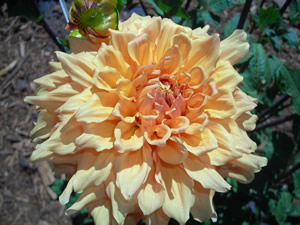| |
Biology 137 2008 Spring Semester
Meta-report 1: Stem Anthocyanin Light Dependence

Dahlia 'Ben Houston', a bronze informal decorative type,
with characeristic tan stems, showing anthocyanin light dependence
Introduction
Anthocyanin pigments can be orange, red, pink, purple, and blue, and are largely responsible for the colors seen in dahlias. Light dependence of anthocyanin biosynthesis has been observed in numerous plant species, including fruit trees, Brassica oleracea, Lycopersicon esculentum, Secale cereale, Petunia sp., Antirrhinum sp., Solanum tuberosum, and Spirodela polyrrhiza, and the genetics of anthocyanin synthesis have been studied extensively in maize (Pierce and Streeter 1931, Mancinelli and Rabino 1984, Quattrocchio 1993, Procissi et al. 1997, Cone et al. 2003). These pigments absorb harmful UV radiation and therefore protect the plant (Stapleton 1994). In many species, even a brief light exposure increases biosynthesis of anthocyanin, while prolonged exposure to visible and near-visible (UV) radiation enables production of large quantities of pigment (Mancinelli 1985, Junko 1988). Interestingly, different genotypes or cultivars within a species may vary in both their degree of pigmentation and their plasticity to light cues (Cone et al. 2003). Such variation suggests genetic control, and indicates that specific alleles dictate different amounts and different sensitivities to light for anthocyanin synthesis induction. Because sunlight contains wavelengths from 290 to 780 nanometers (from UV-B to just beyond visible red light) it is also of interest to determine what quality of radiation is required to induce plants to make anthocyanin. In turnips, it has been shown that anthocyanin biosynthesis can be activated by irradiation with UV-A, but not with red, blue or UV-B (Zhou 2007). In cabbage, which is also a member of the Brassicaceae, anthocyanin production was most effectively activated by irradiation with red, blue and UV-A, whereas far red radiation stimulated no anthocyanin production (Mancinelli and Rabino 1975, Mancinelli 1984, Cashmore et al. 1999).
A good example of how allelic variation alters the amount of anthocyanin and determines whether light is required for pigment synthesis is provided by the C1 gene. The maize (Zea mays) C1 locus encodes a transcription factor regulating synthesis of the enzymes in the anthocyanin biosynthetic pathway (visit here to view the range of allelic variation at this one gene of corn and here to view the range of coloration types). The standard C1 allele permits light-independent anthocyanin accumulation in the maize seed, which develops in the dark within the enclosing husk tissues. The c1-p allele requires light to program anthocyanin, such that there is a single red dot at the attachment point of the silk to the developing kernel because the silk acts as a “light pipe” to transmit photons from sunlight to one spot on each kernel. If the husks are peeled back during ear development, all purple seeds result. The c1-n allele does not program anthocyanin accumulation in the light or dark and is considered to be defective or null.
The present report examines light dependence of anthocyanin production in the stem tissue of dahlia cultivars, considering not only the presence or absence of plasticity, but also its relationship to internode age and growth status. This report synthesizes the work of students in the Spring 2008 quarter of Biology 137; Dahlias in Plant Genetics: E. Abrash, A. Christian, R. Kamber, J. McCallen, A. Schultink, W. White, and C. Young.
Objectives
There were multiple objectives of this study:
- Determine how stem anthocyanin production depends upon light.
- Determine internode age plasticity in anthocyanin production.
- Determine the anthocyanin production plasticity within regions of a single internode.
- Determine the dependence of anthocyanin production on the wavelength of light.
Materials and Methods
Methods of experimentation differed based on experimental objective. For objective (1), internodes were simply chosen at random and covered with 0.5 cm bands of aluminum foil. More methodical choices of internodes and regions within internodes for foil banding allowed experimentation following objectives (2) and (3). Younger or older internodes, based on internode length and turgidity, or apical or basal regions of those internodes were covered in some experiments. For objective (4), foil was replaced with bands of different colors of transparent plastic. Typically treatments were in place for five to seven days prior to data collection.
Experimentation can also explore the responsiveness of dahlias with different initial stem colors. From the database linked here, one can observe up to four different stem colors in our dahlias at Stock Farm: green without anthocyanin production, green with anthocyanin production in those areas exposed to light, tan, and purple. Use of cultivars expressing these various attributes can add an extra variable to experimentation.
Summary Table of Results
Image |
Name |
Stem Color in Control Plant |
Result of Observation
After Stem Covering |
 |
Alpen Diamond |
green,
anthocyanin light dependent |
light dependent;
sensitive at old and young internodes, at varying regions, and at varying wavelengths of light;
clear boundary at foil edge |
 |
Blackberry Ripple |
green,
no visible anthocyanins |
not light dependent;
the plant cannot synthesize anthocyanin because there is a mutation in one of the genes essential for pigment production;
occasionally purple sectors are seen, reflecting excision of a transposon from the mutant gene, excision of which can restore function and permit synthesis of anthocyanin |
 |
CG Elegance |
green,
anthocyanin light dependent |
light dependent;
sensitive at old and young internodes;
clear boundary at foil edge |
 |
Clear Choice |
tan,
some anthocyanins present |
light dependent;
sensitive at old and young internodes;
clear boundary at foil edge |
 |
Fire Mountain |
tan,
some anthocyanins present |
light dependent;
particularly sensitive at young internodes;
clear boundary at upper foil edge |
 |
Honka |
green,
anthocyanin light dependent |
not light dependent |
 |
Kari Fruit Salad |
tan,
some anthocyanins present |
light dependent;
particularly sensitive at young internodes |
 |
Kindred Spirit |
tan,
some anthocyanins present |
light dependent;
particularly sensitive at young internodes |
 |
K-K-K Katie |
green,
anthocyanin light dependent |
light dependent;
sensitive at old and young internodes;
orange stem color under foil |
 |
Lakeview Premier |
green,
anthocyanin light dependent |
not light dependent;
plants strongly phototropic |
 |
Pat' N' Dee |
green,
anthocyanin light dependent |
not light dependent |
 |
Pooh |
green,
anthocyanin light dependent |
light dependent;
sensitive at older internodes |
 |
Moray Susan |
green,
anthocyanin light dependent |
light dependent;
sensitive at old and young internodes |
 |
Smooth Operator |
purple,
high anthocyanin content |
light dependent;
sensitive at old and young internodes;
clear boundary at foil edge |
 |
Teesbrooke Redeye |
green,
anthocyanin light dependent |
not light dependent |
Results and Discussion
The easy to see pigment differences between covered and uncovered tissue zones strongly suggest a light-dependent accumulation mechanism in all varieties with initially tan or greenish stems (with anthocyanin in stems receiving substantial light). Varieties with green stems without visible anthocyanins in the field never made anthocyanin in the experiment suggesting that they lack one or more enzymes (or a regulatory factor) required for pigment synthesis. Interestingly, plants with intially purple stems appear to exhibit no correlation between light and anthocyanin production as is observed with the standard C1 allele of maize (see the Introduction).
For the responsive varieties, pigmentation reduction as a result of foiling was generally stronger in younger internodes (those still expanding in length) than in the older internodes closer to the base of the plant. Additionally within an internode, there was a stronger response in the apical region of a given internode than in the base, and stronger at the apical edge of a foiled area than at the basal edge. As the apical part of an internode is younger, these observations suggest that there is a “phenocritical” time when stems are maximally responsive to the light signal and that as stems age, the tissue is less likely to respond to light by synthesizing anthocyanin. It would be interesting to determine how long this “phenocritical period” lasts: when to internodes acquire responsiveness to light and when do they lose it? Also, for how many hours or days must internodes be exposed to light during the phenocritical period to induce synthesis of anthocyanin? Is the amount of anthocyanin proportional to the amount of light, or is a short period of light treatment sufficient to induce the maximal pigment production?
In Alpen Diamond, the only cultivar to be tested for light spectra induction of anthocyanins, red light produced anthocyanins, and stems covered in red, green, or yellow plastic showed no reduction in anthocyanin concentrations. Only stems covered by blue plastic showed a reduction in anthocyanin synthesis. Red light is perceived by the phytochrome pigments – is red or far-red light required for pigment synthesis? This is an important question because red light induces production of the Pfr form of phytochromes while far red light causes the existing Pfr to switch to the Pr form. Pr and Pfr act in opposition, therefore, if red light induces anthocyanin a pulse of far-red light should prevent anthocyanin synthesis. For all of the anthocyanin producing varieties more intense pigmentation was observed outdoors with solar radiation than in the greenhouse, which has substantial visible light but lacks both UV-A (320 – 400 nm radiation) and the more energetic UV-B (280 – 320 nm radiation). As a major role of anthocyanin is to act as a UV sunscreen, it is logical that pigment synthesis would be regulated by the amount of UV present. To date, the photoreceptor(s) for UV-B photons has not been identified, however, cryptochromes are activated by UV-A radiation. Would illumination with both red (or far red) and UV cause more anthocyanin pigmentation than just one type of radiation alone?
Figure 3. Dahlia Smooth Operator with foil coverings with a slit or hole. In this protocol most of the foiled area gets no light but a small region receives the same radiation as the rest of the plant. This is a type of control to document how much anthocyanin the covered region is capable of synthesizing in the light during the experimental period. |
|
|
See the full table of foil and plastic film results from summer 2008 here (.xls)
Read foiling and plastic protocol here (.doc)
References
Cashmore, A.R. et al. 1999. Cryptochromes: blue light receptors for plants and animals. Science.
392: 760 -765.
Junko, T. 1988. Light-induced synthesis of anthocyanin in carrot cells in suspension. Department of Agricultural Chemistry, Faculty of Agriculture, Kyoto 606, Japan.
Cone, K.C., et al. 1993. Role of the regulatory gene pl in the photocontrol of maize anthocyanin pigmentation. The Plant Cell. 5: 1807–1816.
Mancinelli, A.L. 1985. Light-dependent anthocyanin synthesis: A model system for the study of plant photomorphogenesis. The Botanical Review. 51:107.
Mancinelli, A.L. 1984. Photoregulation of anthocyanin synthesis. Plant Physiology. 75:447-453.
Mancinelli, A. L. and I. Rabino. 1984. Dependence on photosynthesis of high irradiance response anthocyanin synthesis in Brassica oleracea leaf disks and Spirodela polyrrhiza. Plant & Cell Physiology. 25: 1153-1160.
Mancinelli, A.L. and I. Rabino. 1975. Photocontrol of anthocyanin synthesis: IV. Dose dependence and reciprocity relationships in anthocyanin synthesis. Plant Physiology. 56:351-355.
Pearce G. W. and L.R. Streeter. 1931. A report on the effect of light on pigment formation in apples. Journal of Biological Chemistry. 92: 743.
Procissi et al. 1997. Light-dependent spatial and temporal expression of pigment regulatory genes in developing maize seeds. The Plant Cell. 9: 1547-1557.
Quattrocchio, F., et al. 1993. Regulatory genes controlling anthocyanin pigmentation are functionally conserved among plant species and have distinct sets of target genes. The Plant Cell. 5:1497-1512.
Stapleton A.E., and V. Walbot. 1994. Flavoids can protect maize DNA from the induction of ultraviolet radiation damage. Plant Physiology. 105:881-9.
Zhou, B., et al. 2007. Ultraviolet A-specific induction of anthocyanin biosynthesis in the swollen hypocotyls of turnip (Brassica rapa). Journal of Experimental Botany. 58: 1771-1781.
Download the Text (.doc)
Download the foil protocol (.doc)
Download the results table (.xls)
         
|



